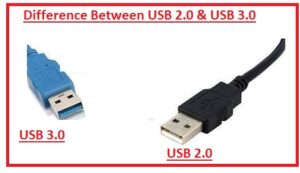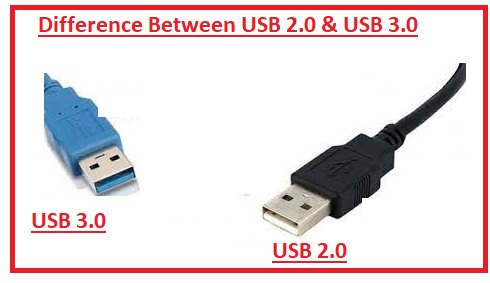 Hello, readers welcome to new post. In this post, we will learn Difference Between USB 2.0 & USB 3.0. Universal Serial Bus (USB) ports and ports are tools that allow you to connect computer inputs to your computers, keyboards, external hard drives, or storage keys.
Hello, readers welcome to new post. In this post, we will learn Difference Between USB 2.0 & USB 3.0. Universal Serial Bus (USB) ports and ports are tools that allow you to connect computer inputs to your computers, keyboards, external hard drives, or storage keys.
The numbers following the USB signal simply correspond to the standard USB standard, series 3.0 and 3.1 being the most recent at the time of writing these lines.
Difference Between USB 2.0 and USB 3.0
In addition to the color of their connectors (version 3.0 is usually blue), it is the data transfer speed that is the main difference between the two standards.
Thus, the standard USB 2.0, introduced in 2000, made it possible to ensure that the transfer speed was much higher than at the previous level: from 1.5 MB per second to 60 MB of theory! USB 3.0, which appeared in 2008, doubled the transmission rate by 10, reaching a maximum of 625 MB per second!
Note, if the reverse interaction is supported in USB 3.0 jack mode (i.e., your device with a USB 3.0 port will run on your computer with USB 2.0 sockets), the transmission speed will remain restricted to 2.0 levels …
USB rates. In early 1995, the USB standard was developed for connecting various devices.
USB 1.0 standard offers two types of communication:
12 Mb / s in speed mode.
1.5 Mb / s at low speed.
USB 1.1 standard provides some specifications to USB device manufacturers but does not change the bit rate.
USB 2.0 standard provides speeds of up to 480 Mbit / s.
USB 3.0 standard has speed values of about 4.8 Gbps.
If there is no logo the best way to find out if these are USB devices at low or high speeds to view product labels as long as the connectors are the same.
Interaction among different USBs 1.0, 1.1, and 2.0 devices are confirmed with the use of USB 2.0 devices in a low-speed USB port will limit the bit rate to 12 Mbps. In addition, the application may display a message stating that the flow will be blocked.
USB port:
There are two main types of USB connections.
First, one is Type A connectors, that are rectangle-shaped used for low bandwidth devices such as web camera, keyboard
Another one is Type B connectors, that has a square shape and are mostly used for high-speed devices like outer hard drives
Definition: USB Type A and Type B connectors
1. Power + 5V (VBUS) 100mA maximum
Data (D-)
Data (D +)
Mass (GND)
USB bus operation
USB tethering has a power supply feature for connections, up to 15 W per device. It uses a cable that contains four cables (ground GND, VBUS power supply and two data cables called D- and D +).
Explaination: USB cable
USB standard allows device binding, using bus or star. Devices can then be connected sequentially, or by branch.
Branching is done using boxes called “hubs”, with one input and a few outputs. Some are active (providing electricity), some are inactive (computer-enabled).
Definition: The topology of the USB port bus
Definition: The star of the USB ports
The communication between the host (computer) and the activities is done in accordance with the rule of thumb (communication language) based on the principle of the token ring. It indicates that bandwidth is linked among all connected modules. The host (computer) sends the first signal in a series of milliseconds (ms), a period of time in which it will give a “speech” simultaneously. When the host wants to communicate with the device, it sends a token (a packet of data, containing the address of the device, embedded in 7 bits) that identifies the device, so the participating administrator “determines” the dialogue parameters. If the device sees its address in the token, it sends a data packet (8 to 255 bytes) in response, otherwise, it transfers the packet to other connected devices. The data exchanged was encrypted according to NRZI encoding.
Since the address contains 7-bit codes, 128 devices (2 ^ 7) can be connected simultaneously to a port of this type.
USB 2.0 vs USB 3.0
A table highlighting the primary changes between USB 2.0 and USB 3.0 is provided here.
| Feature | USB 2.0 | USB 3.0 |
|---|---|---|
| Transfer Speed | Up to 480 Mbps | Up to 5 Gbps |
| Compatibility | Backward compatible with USB 1.1/2.0 | Backward compatible with USB 1.1/2.0 devices |
| Power Consumption | Higher power consumption | Lower power consumption |
| Data Transfer | Half-duplex | Full-duplex |
| Cable | Four-wire cable | Nine-wire cable |
| Ports | Black or white | Usually blue |
| Cost | Generally less expensive | Generally more expensive than USB 2.0 devices |
| Advantages | Widely available | Faster transfer rates |
| Disadvantages | Slow transfer rates | Higher cost |
Advantages of USB 3.0 over USB 2.0
- The USB 3.0 has many advantages to USB 2.0 that are listed here
- It comes with high-speed transfer rates
- It is more efficient than USB 2.0
- It has Full-duplex data transfers
- It has a good ability to manage power
- It enhances the data encoding
Which one should you choose: USB 2.0 or USB 3.0?
- USB 3.0 is the ideal option if you routinely transmit huge data, such high-definition films or photographs. However, USB 2.0 is adequate if you simply need to connect simple devices, such a keyboard or mouse.




